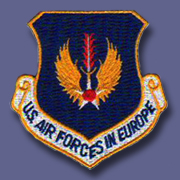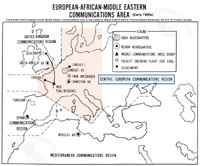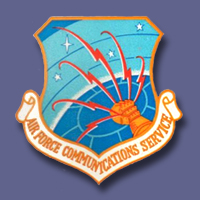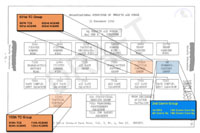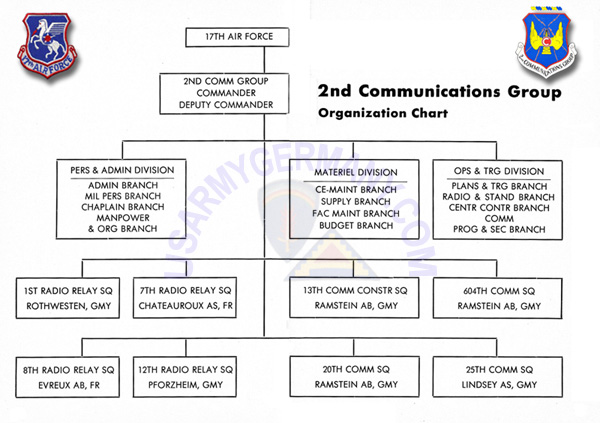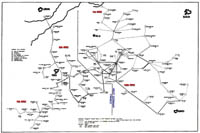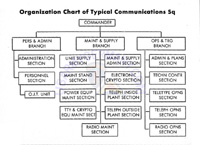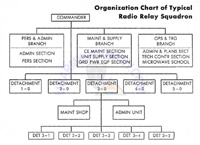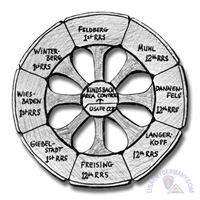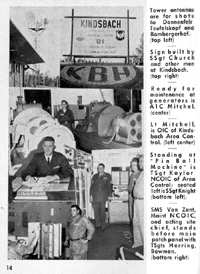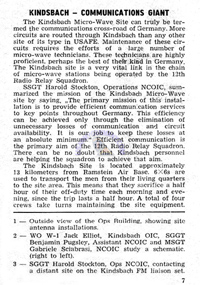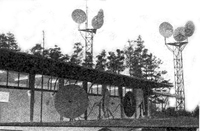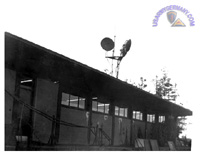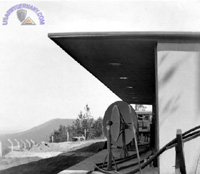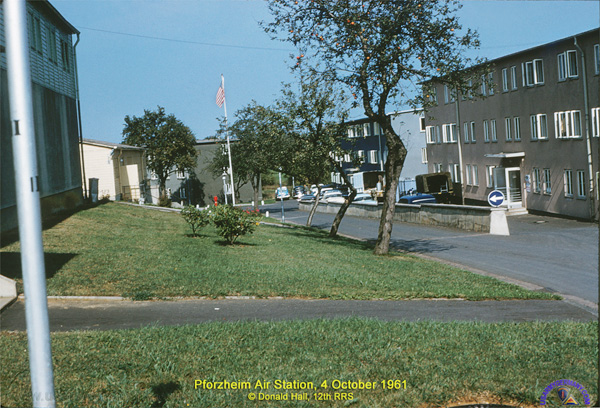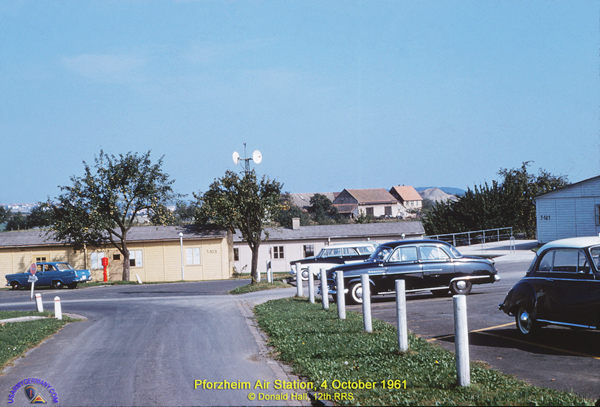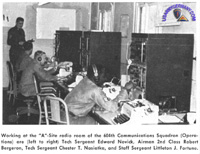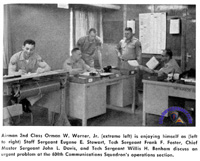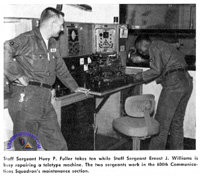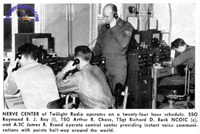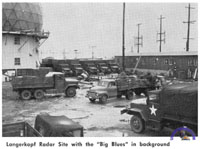Tactical Air Control System |
||||
|
||||
| Communications | ||||
| EARLY 1960s | ||||
| General | ||||
| (Sourse: STARS & STRIPES, February 5, 1958) | ||||
| The headquarters of the European-African-Middle East Airways and Air Communications Service Area began operations at Lindsey Air Station in early 1958 after completion of its move from Bitburg AB. The relocation was made to achieve greater operational efficiency and economy by colocating the command with USAFE Headquarters. Current commander of the AACS area hqs is BrigGen Haskell E. Neal. |
||||
| (Source: The CommNet, May/June 1962) | ||||
|
||||
| Following the CENEUR Commander's introduction, Lt Col John S. Simonsen, director of personnel, opened the series of briefings scheduled with a discourse on various personnel problems connected with the current consolidation of the region headquarters here. Other speeches held at the CENEUR commanders' conference included briefings on logistics, telecommunications, command post operations, area frequency problems, manpower questions, electronics, comptroller activities, administrative policies and many other fields. The conference wound up with an open discussion period followed by the region commander's closing comments. An informal cocktail and dinner party in the Ramstein Officers' Club Miami Room concluded the event. |
||||
| AC & W COMMUNICATIONS SYSTEM | ||||
| (Source: SIGNAL, November 1960) | ||||
| From early 1951, when SHAPE was first established until the present (1960), NATO has spent upwards of $500 million for a carefully planned communication infrastructure program extending extending throughout all Western Europe to provide the military circuits which SHAPE would require in time of war. Although NATO planned and paid for the systems, the post-telephone-telegraph systems (PTT's) of the individual countries did the actual construction and integrated the circuits into their civil systems for regular toll use during peacetime. The time required for SHAPE to call circuits into military use varies from an hour or so for the highest priority, to a few days for circuits of lower priority. It was recognized that this would not cope with the needs to meet a surprise attack. The requirement was to establish a system which would provide reliable, secure and virtually instantaneous communications for Allied Command Europe (ACE). SACEUR (Supreme Allied Commander Europe) was designated coordinator of Air Defense for NATO Europe and directed to develop an appropriate system for coordinating air defense efforts and capabilities. Special importance was attached to the rapid dissemination of information to command and operational elements, and the quick implementation of military plans. This system was to provide SACEUR a military communications system connecting his headquarters with the national and regional headquarters in Allied Command Europe. In order to guard againts attack, it was deemed vital that the network be immediately available to SACEUR at all times, particularly during a period of increased air activity, tension or alerts. This resulted in the initiation of Project Ace High. The Ace High communications system will cover all of Western Europe from the northern tip of Norway well above the Arctic Circle to the eastern edge of Turkey, approximately 1,000 miles into the continent of Asia. When completed, Project Ace High will consist of 86 stations divided almost equally between over-the-horizon and line-of-sight stations. The total route distance of the entire system will be approximately 9,000 miles. |
||||
| Project HOT LINE (Signal, November 1960) - a four-station troposcatter link between Oslo (AFNORTH) north to Bodo, Norway (first phase) Project DOUBLE JUMP (Signal, December 1959) - an ionospheric scatter link that connects SHAPE with its subordinate headquarters in Naples (AFSOUTH) and Izmir (second phase). |
||||
| 2nd Communications Group | ||||
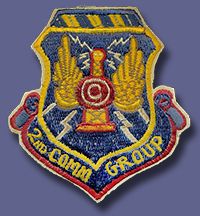 2nd Communications Group Patch 2nd Communications Group Patch |
||||
| (Source: Command Report EUCOM-USAREUR, 1952) | ||||
|
||||
| (Source: STARS & STRIPES, Nov 14, 1953) | ||||
| The mission of the 2nd Communications Group in Ramstein is install, operate and maintain all communications facilities and services required within the headquarters of the 12th Air Force and between the headquarters and subordinate units in the field. The 2nd Comm Gp consists of CO of the Gp is Col William H. Lyle. The Group installas cables required for the permanent air bases assigned to the 12th AF and maintains a constant check on all telephone, teletype and radio communications within the 12th. During maneuvers, the Gp also maintains connections between the 12th AF's command post and the distant outposts. |
||||
| (Source: The Comm Net, June 1961) | ||||
|
||||
| (Source: THE COMM NET, June 1961 Edition, courtesy 12th Radio Relay Squadron Yahoo Group) | ||||
| Second Communications Group Completes Decade of Support To U.S. Air Forces in Europe On October 25, 1951, as a "small war" raged across craggy Korean hills on the other side of the world, a typist in the headquarters of United States Air Forces in Europe completed USAFE General Order Number 79. This General Order activated the 2d Communications Group. People for the group come from resources available to Headquarters, Twelfth Air Force, and the group headquarters was established at Landsberg Air Base, Germany. Landsberg was not to be the home of the 2d Communications Group for a long time, however, for at grid coordinates 4926N 0732E sat Ramstein Air Base, Germany, soon to be the new home of the group. In April of 1953, Twelfth Air Force headquarters published Movement Order 53-9, which directed relocation of the unit from Landsberg to Ramstein. Its mission was "to install, operate, and maintain all communications services and facilities required within Headquarters, Twelfth Air Force, and between that headquarters and subordinate units in the field . . and to carry out, on short notice, such special missions as may be directed by the Commander, Twelfth Air Force." |
||||
|
||||
| Technical School Founded The construction of a 2d Communications Group Technical Training School was also begun during this period. A 20x80-foot prefabricated building, it was to house classes in military ground training, microwave fundamentals, and teletype procedures. As the Christmas season approached during 1954, the 2d Cammunications Group made an outstanding gesture toward good community relations, as, on Dec 17, several hundred members of the group drove to Nussbach, Germany, where they sponsored a Cristmas party for the children. Bags of assorted candies, fruits, nuts, dates and chewing gum were distributed to the village children. Every child between the ages of one and sixteen was given a pair of shoes. In appreciation of this Yuletide gesture, the Bürgermeister of Nussbuch sent a letter of thanks to the 2d Communications Group Chaplain. Joins Exercises Through June 1955, the group participated in Operations Beeline, Sky-High, Sting Ray, Servex I, Vapor Trail II, and Exercise Carte Blanche. Carte Blanche, a field maneuver, saw the group operate under field conditions in many areas, adding teletype and speech circuits to existing facilities; installing systems between other air bases and deployment areas; and maintaining round-the-clock operation of the Kindsbach Communications Center. A fire warning system was completed at the Chize Ammunition Depot, France, where 1,068 poles with anchors and guys were installed, over 30 miles of open wire and 26,000 feet of cable were strung and laid, and 38 terminals, 196 telephone jacks and protectors installed. Further expansion was accomplished by the 2d Communications Group and its units at Hahn Air Base, where a complete facility survey was done; at Birkenfeld, where 50,000 feet of 40-pair cable and 80,000 feet of 26-pair cable was rehabilitated; at Metz, France, where new 75-foot poles were set in solid rock; and at Dreux Air Base, France, where new switchboard facilities were installed. Colonel Joseph C. Dillow replaced Colonel Glenn R. Kraus as the Group Commander in August, 1955. Expansion of communications facilities continued during 1955 of Twelfth Air Force bases in France - where telephone facilities for 150 trailer units were provided and outside telephone plants were started; at Sembach, where keying and communications lines were installed from tower to GCA units; at Ramstein, where telephone facilities were provided for 3 new billets. In addition, an AN/TRC circuit was installed between Kindsbach and Loan Air Base, and the microwave system in being was re-engineered. Assistance Rendered Emphasis on community relations gained new impetus during this first half of 1956. The 2d Communications Group became well known for its good-will visits and gifts to local institutions and homes of the needy and afflicted. In addition, construction units of the group furnished assistance to local communities in water, and drainage systems. At Nanzweiler, Obermohr and Steinwenden alone, ditch-digging machines dug over 2,210 meters of ditch for drainage systems. This "Help-Your-Neighbor' policy was not restricted to civilian villages only, but was also extended to local and remote military units. Projects Completed During the last 6 months of 1956, the 2d Communications Group and its units were faced with rehabilitation and expansion problems throughout Germany and France. By direction of Twelfth Air Force, many communications projects were accomplished from Ramstein itself to Fort Jeanne D'Arc in Metz, France, and in locations such as Kindsbach, Marktheidenfeld, Würzburg, Giebelstadt, Rothwesten, Bambergerhof, Zweibrücken and Spangdahlem, Germany. Community work was continued at Mackenbach, Germany, where 10 truckloads of fill dirt were token to level off the village soccer field, and at Bonn, Germany, where 1,000 feet of trench was dug to facilitate burying of water and sewage pipes and school play areas were leveled. Lieutenant Colonel Brady Cole replaced Major Edgar L. Gibson as Deputy Commander of the 2d Communications Group in April 1957. During early 1957, the 2d Communications Group participated in two major command post exercises. The first of these, Exercise Lion Noir, involved the majority of all NATO forces. Communications support was furnished the 7th Army field units of Bad Kreuznach, Germany. Tests Mobility Big Deer exercised mobile capabilities of USAFE (ADVON) with a pre-exercise test of communications (Little Deer). Since the latter exercises were limited in scope, few circuits were involved. To test its own alert notification and convoy formation procedures, the 2d Communications Group conduced on exercise of its own on 2 May 1957. Called a mobility exercise, it pinpointed lack of fast dispersal procedures for vehicles and inadequate staging areas for convoy formations. As a result, three special convoy formation areas were tentatively selected to handle fast, purposeful dispersal and formation of comunicotions vehicles. On 10 October 1957, the 2d Communications Group Technical Control Facility was formed. Its purpose was to consolidate technical control functions previously done by several units. To Become Wing The group's expansion, particularly during the last six months of 1957 was tremendous, both from personnel-strength and area-of-responsibility standpoints. As as result, group planners formulated and sent to higher headquarters a proposed reorganization of the group into a wing structure. Approved by Headquarters, USAFE, the plan was forwarded to USAF for possible final approval. Assigned to USAFE On 15 December 1957, the 2d Communications Group reverted from Twelfth Air Force to direct assignment to Headquarters, United States Air Forces in Europe. In the midst of this reorganization, pursuit of other projects and communications construction continued at a fast pace. In the latter half of 1957, 290,609 feet of cable was installed; 243,830 feet of trench was dug, 63 poles placed; 5 antennas and 7 towers installed. Outside cable plants were completed at Wiesbaden, Giebelstadt, Kitzingen, Fürstenfeldbruck and Kaufhusen, Germany. With the group's assignment to USAFE, its mission statement also changed. USAFE (ADVON) defined this mission of the 2d Communications Group as follows: 'To furnish communications support to USAFE, to include installation, operation and maintenance of tactical and fixed telecommunications facilities. . . In addition . . . will establish telecommunications facilities in support of headquarters above wing level . . . non-AF or allied units (support) will be in accordance with policies (of) . . . the Deputy Chief of Staff, Communications. Revamping Continues And so, complete with a realigned mission, the 2d Communications Group passed into the new year of 1958 still in the process of reorganization. Construction continued during the first half of 1958 and consisted of expansion and modernization of outside telephone plants at various USAFE stations. In addition, 'Project Caravan' (installation of telephone facilities in 8 trailer parks on bases in France) which was started in 1955 was completed. Operational units of the 2d Communications Group saw activity in the field again as they participated in 3 major exercises. For Exercise Sabre Hawk and Lion Bleu, the USAFE (ADVON) Combat Operations Center communications were set up by the group at various field locations. Exercise Full Play primarily demanded monitoring activities from the group since Army units supplied all communications at field locations during the exercise. Helps Lebanon Troops International tension brought the resources of the 2d Communications Group into full play in July 1958 as the crisis in Lebanon received world-wide attention. Urgent requests for antenna-supporting structures as well as antenna supplies were received by the group. Requests for immediate communications surveys were also received. Rhombic antennas, both receiving and transmitting, were required overnight, and were in place in time to support USAFE communications requirements during the Lebanon crisis. In October 1958, the group accomplished a survey of communications requirements at Ankara, Turkey, in support of a proposed flight service center. It was determined that AN/TRC-24 radio sets utilizing CF-1 and CF-2 carrier equipment would accomplish the job. Subsequently, on 8-11 December 1958, airmen and 67,441 pounds of a uipment were airlifted in two V124 aircraft from Ramstein to Ankara. Between July and December 1958, many changes occured in the microwave and AN/TRC radio relay systems. Increases in channelization were made, AN/TRC-1 was replaced in certain areas with double AN/TRC-24 systems, towers were extended, phaseout of AN/TRC-1 operating locations was made and many circuits rerouted over microwave facilities. These changes, in many instances, doubled the communications capability, and improved flexibility. This resulted in an increase of circuit hours committed to operate from 463,608 to 583,488 and involved coordination and accomplishment of approximately 350 separate circuit actions. Col Judkins Takes Over Colonel William T. Judkins replaced Colonel Joseph P. Dillow as Group Commander on 30 July 1959. September 1959 brought Exercise Side Step. During this exercise, the 2d Communications Groups Central Control Facility acted as the control agency for all communications services of the group and as an exercise teletype-communications link between the group and subordinate units. Deliberate efforts were made, unsuccessfully, to overload the radio control system in order to simulate wartime conditions. Also in September 1959, $19,000 was allocated for improvement of the Base Communications Center. Improvements were to consist of expansion of available floor space and overall modernization of the facility. This communications center is to serve as a command communications hub of the entire USAFE Command Teletype Network. Placed under 17th AF In November 1959, the 2d Communications Group was removed from direct USAFE control and assigned to Seventeenth Air Force. Members of the group again become 'Santa" in December 1959 to the Old Folks' Home at Germersheim, Germany. Donations were collected and personal gifts given to each member of the home. Also in December 1959, the information program of the Group forged ahead, as the first issue of the group magazine came off the press. Initially called News and Views, it was later renamed The Comm Net after an extensive 'Name-the-Magazine` contest. Lieutenant Colonel John L. Jernigan replaced Lieutnant Colonel Brady Cole as group Deputy Commander. January 1960 saw the creation of incentive for the maintenance of morale and leadership within the group structure. A morale leadership program was instituted involving trophies to be awarded units with 'high' and 'low' standings based on number of accidents, bad checks, reenlistment rates, etc. EUCOM Exercise Held In February 1960, the group participated in several exercises. Exercise Ski Jump was conducted in cooperation with the US European Command in order to test movement plans. In July 1960, an award program was instituted which had as its goal the attainment of high operational efficiency by operating locations assigned to the 2d Communications Group. Called the Outstanding Pennant Award, it consisted of the awarding of pennants to Operating Locations on a quarterly basis, based on (1) Systems Performance, (2) Ground Safety, (3) Morale Leadership, (4) OJT Effectiveness, (5) Site Appearance and improvement efforts and (6) Community Relations. Winning sites fly pennants from sunrise to sundown below the United States flag. Comm Survey Ordered The 2d Communications Group was directed by Seventeenth Air Force to conduct a communications center survey of all communications facilities on the European continent. Its purpose was to consolidate all communications centers within the group. Two teams were dispatched from the group headquarters and units to conduct this survey. Fifty-three communications centers were scrutinized, and survey teams compiled detailed information for possible consolidation of the centers. This plan was forwarded to Seventeenth Air Force for consideration. Sent to Congo In the summer of 1960, the Congo crisis erupted. 2d Communications Group single-sideband radio teams were deployed to the Congo to support airlift operations. These teams were formed from personnel of the 604th Communications Squadron. In addition to their primary mission, they provided communications to outlying missionairies and 'Ham' operators throughout the Congo. Major sites of operation were Leopoldville, Entebbe, and Kindu. In October 1960, the group headquarters was relocated on Ramstein Air Base. The move solved space problems incidental to the formation of the 86th Air Division (Defense) which consolidated and absorbed the 501st Tactical Control Wing. |
||||
|
||||
| (Source: The Comm Net, Feb-Mar 1962) | ||||
| Ramstein CCF Is Nerve Center Of USAFE Radio Relay System The 2nd Communications Group Central Control Facility at Ramstein AB, Germany, in its new function as the USAFE Central Control Facility (CCF), has become the nerve center of the entire U.S. Air Force radio relay system in Europe. This development is the result of an order issued by Headquarters United States Air Forces Europe in an effort effectively to consolidate its vast radio-relay communications system. Needs Reorganization When the full significance of the USAFE action was realized as added authorities and responsibilities were outlined in the resulting correspondence, the need for internal and external reorganization become evident. To consolidate and centralize control functions further a proposal was approved by CINCUSAFE to make the area control facilities at Kindsbach (Germany) and Vernou (France) detachments one and two, respectively, of Headquarters 2nd Communications Group, operational direction to be exercised by USAFE CCF. In addition, the 3rd Communications Group in the United Kingdom was directed to establish an area control at Hillingdon and necessary sub-controls for controlling the radio relay system in Britain, with overall operational control also vested in USAFE CCF. The magnitude of this huge communications complex can best be realized when described in figures: It includes nearly 200 sites and operating locations extending from Italy through West Germany, France and Belgium to the United Kingdom. The centralization of control in USAFE CCF provides CINCUSAFE and the commander of the 2nd Communications Group with an effective medium for obtaining instantaneous information on any of the 1,100 circuits and 125 links in the system. Handles Distribution The Central Control Facility also functions as the distribution agency for all permanent, temporary and maneuver, circuit- and link-install, cease and rearrange authorities received from Headquarters USAFE. This distribution is made to all headquarters and bases concerned, and in many cases coordinated with the U.S. Army signal agency at Heidelberg, by the fastest means available. As the final clearing authority for all planned outages on the radio relay system and coordinating agency for emergencysystem outages, USAFE CCF must obtain approval from using agencies such as the Seventeenth Air Force combat operations center, Headquarters 86th Air Division, or Headquarters 38th Tactical Missile Wing. From its original modest beginning as a 2nd Communications Group facility, USAFE CCF has developed info one of the most important operational instruments available to the Commander-in-Chief of the United States Air Forces Europe. |
||||
| 1st Radio Relay Squadron | ||||
| (Source: The Comm Net, Dec 1961) | ||||
| Brief Unit History Company "D", 926th Signal Battalion was activated on 1 Sept 1943 at the US Army Air Forces Station of Aldermaston Courts, England. In July 1944, the unit accompanied the 9th Tactical Air Command in the assault on the European continent and finished WWII at Bad Kissingen, Germany. (Between the end of WWII and 1948, the unit was reorganizaed and redesignated as the 926th Signal Outpost Operations Company.) At Camp Pieri near Wiesbaden, the 926th Signal Outpost Operations Company was reorganized on 5 Nov 1948 and redesignated as 1st Radio Relay Squadron in the United States Air Force. On 23 Dec 1951 the squadron was the first radio relay squadron assigned to the 2nd Communications Group. Through the years the 1st had utillized the old AN/TRC-1 radio relay equipment. Long service and almost constant mobile operations had long since taken toll of this equipment when in the fall of 1958, sufficient off-shore procured microwave equipment was installed to retire the old AN/TRC-1 systems. In January 1959, the 1st Radio Relay Squadron was phased down to a morning-report one-and-one organization. During the summer of 1959, plans were developed for the integration of radio relay circuits operated by the 38th Tactical Missile Wing and the 501st Tactical Control Wing into the overall USAFE radio relay system operated by the 2nd Comm Gp. Most of the circuits had been deployed as strictly mobile installations in the area of the old British occupation zone in northern West Germany. On 1 July 1960, the 1st Radio Relay Squadron was re-activated as a full squadron and assigned the task of renovating, rehabilitating and rearranging the old mobile circuitry. Many and diverse were the problems confronting the new squadron. The technical know-how and the ability to improvise displayed by the commander and men of the 1st RRS has now provided that area with reasonable fixed plant extensions to the USAFE radio relay system. |
||||
| 12th Radio Relay Squadron | ||||
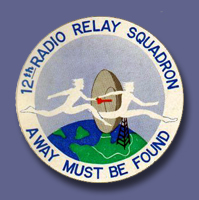 12th Radio Relay Squadron Insignia 12th Radio Relay Squadron Insignia |
||||
| (Source: The CommNet, November 1961 Edition, courtesy 12th Radio Relay Squadron Yahoo Group) | ||||
| There's No Confusion at the 'Hub', Just Lots of Work and Know-How by Lt. Charles W. Mitchell As you walk into a busy room in the westernmost part of West Germany, you see flashing lights, you hear the disconcerting chatter of teletype machines, and you also hear a two-way conversation going something like this, '. . . Muhl, I've an outage for you - the 38200 Teletype Group on a G-7 at 1400Z, running open at Kindsbach Sub, initials Alpha Kilo, yours please . . . Kilo Metro . . . check how it's coming through you.' And as you turn for a closer look at the adjoining room, you hear the continuous melody played by blower bays for microwave communications equipment, and you hear another group carrying on a conversation such as, 'Put a mark on circuit 42002 toward Pforzheim for a level check . . . Control, there's no steady ring indicated through here on 306 . . ." When you have been in the building for about 10 minutes, you find (unless you are a well-seasoned communicator) that you are hopelessly confused. Someone then taps you on the shoulder and tells you something you had probably guessed before, 'You are at 12th Radio's Kindsbach Area Control.' |
||||
|
||||
| Although Kindsbach communicators look toward the future rather than the past, a few highlights of its history ought to be mentioned. Organized as a part of the 12th Radio Relay Squadron (OL 12-1) in December 1956, Kindsbach Area Control has progressed from a few desk telephones and communications vans to one of the most modern sites in West Germany. Until early this year, personnel worked in and out of vans linked by hundreds of cable pairs with the actual control facility located in a small room of the power shed. Today the site is blessed with permanently installed communications equipment, including the recently acquired 'Pin Ball Machine,' in a permanent building. Today's equipment includes three complete German made FM systems with 19 VZ 12 carrier bays and 11 WTT-1 teletype bays attached (shots to Dannenfels, Teufelskopf and Bambergerhof), one off-shore procured PPM 24 system (shot to Ramstein) with a WWTT-6 teletype bay, two racks of American CT-2 teletype equipment, two area control consoles, the remote supervisions system, a complete flywheel generator system and the equipment necessary to keep the above systems operating. The personnel situation at OL 12-1 is unique in as much as it is the only operating location in the 1st and 12th Radio Relay Squadrons where channel and technical control personnel are employed. Eleven men, nine from the 12th and two from the 1st Radio Relay Squadron, operate the area control facilities. Sub-Control personnel with 11 microwave-maintenance slots provide all maintenance except for power facilities which are handled by one ground power maintenance man. Currently assigned are one officer and 24 enlisted men, 21 of whom are non-commissioned officers. Most of the maintenance personnel are retrainees who have proved that diligence and perseverance can make a man an expert in his field in a minimum of time. We of Kindsbach are very proud to be able to say that "a way has been found." This is not to claim that all our goals have been reached; a unit whose members feel that everything is ideal is a stagnant unit. We shall strive to live up to our charter and our responsibilities, to find better ways and improve old ones; and to set and follow principles guaranteeing the continuous and efficient operation of the 17th AF microwave system. Being one of the enforcers of Regulation 100-18, Kindsbach may be a "dirty word" to some within the system - but those who have worked at OL 12-1 will take pride in looking back and be justified in saying to themselves "Well Done." |
||||
| (Source: The Line of Sight, 12th RRS magazine, Nov-Dec, 1957) | ||||
|
||||
|
||||
|
||||
|
||||
| (Source: Email from Gary Merkel, moderator of the 12th Radio Relay Squadron Yahoo Group website) | ||||
| The 12th RRS provided communications for all AF Units in Germany, not just the radar installations, although there were a bunch of them. (Remember) the map shown above in the 2nd CG section is just one picture in time, 1961. The system was in pretty much constant flux from what I gather. At one time we also took over all of the 1st Radio Relay Sites that dealt with Tropo and Microwave. Basically we handled Southern Germany, but that wasn't always the case since the line between Southern and Northern seemed to fluctuate back and forth. Some of the links in France were ours too, temporarily, while the 7th RRS was constructing their permanent links. I also know that the 1944th had sites at Baden-Baden/Bad Sollingen for the Canadian Base. Just so you get a feel for the time frames the 12th RRS was activated 12/1/56 and deactivated 7/1/62. The 2060th RRS was activated 7/1/62 and deactivated 1/1/65. The 1944th Comm Sq was activated 1/1/65 and deactivated sometime in late 1966 or early 1967. All were Headquartered in Pforzheim. I left Pforzheim in Sep of 1966 just before they closed the base and everything got moved to the 1945th Comm Sq. ADDITIONAL INFORMATION 12/1/1956 - The 12thRRS was activated at Pforzheim AS (then called Pforzheim Aircraft Control & Warning Station). Pforzheim was the Headquarters from the beginning to the end. From other members (of the 12th RRS Yahoo Group) , I gather that some of them were sort of in a holding status "Awaiting Further Orders" (AFI) at Ramstein AB in the 1st RRS, waiting for this event to occur. No mention is made, in any documentation so far, that there were any sites, but I'm sure the 12th took over some of the southern sites operated by the 1st RRS in addition to creating some of their own. 3/15/1957 - The 1st RRS was deactivated, actually I think I read that it was born again as a MOB unit at this time, or shortly thereafter. All their sites were turned over to the 12th RRS...this is a little confusing to me since one of the "Line of Sight" publications said the 12thRRS only had a total of 25 sites after this occurred...sure seems like it would have been more. 7/1/1962 - The 1st RRS was reactivated and took back some of the Northern Radio Relay Sites. I do not have a clear indication of how many sites the 12th RRS had at that time. On this date, the 12th RRS was deactivated and the 2060th RRS was activated at Pforzheim AS, taking over everything formerly owned and operated by the 12th RRS. At this time AACS became history and AFCS was created. The 2nd Comm Gp ceased to exist and was taken over by the Central European Communications Command. 1/1/1965 - The 2060th was deactivated and the 1944th Communications Squadron was activated at Pforzheim AS, taking over everything under the 2060th. 10/1966 (?) - The 1944th CS was deactivated and everything turned over to the 1945th Communications Squadron out of Rhein-Main AB. Pforzheim AS was closed, but later came to life again as an Army Maintenance Facility in support of the Nike base across the valley. (Their Headquarters Unit was out of Karlsruhe.) It then became the Maintenance Facility for the Pershing Missiles stationed in southern Germany, under the same Army Unit. When "The Wall" fell, the Army moved out (the Pershings were gone) and the base became a refugee camp for displaced persons from the Eastern Bloc countries. It was eventually leveled and the Bundespost constructed a huge facility there that is still in use. Additions, corrections or comments would be greatly appreciated! |
||||
| 1961 | ||||
| (Source: Email from Donald Hall) | ||||
| The first day at Pforzheim AS I thought what kind of outfit have I gotten into when I was issued field gear and a carbine. I was there from August 9th until November 2, 1961. I worked in the microwave radio maintenance depot shop for about a month and then went to USAFE Siemems & Halske microwave school which was located there. After completing the school which was about six weeks in length I was transferred to Langerkopf. Pforzheim would have been the dream assignment. Food was above Air Force standard. Barracks were good. Pforzheim was a small city with less than 300 American stationed in the area. Local German population did seem to mind us. While I was there the Berlin Wall Crisis escalated. After lunch one Friday, squadron commander, Col. Joseph Waterman, took all 12th Radio Relay Personnel stationed there on a quarterly five mile hike with full field gear (back pack, tent half, canteen belt with canteen, trenching tool, carbine and helmet). I remember seeing a US Army low boy with a huge cannon mounted on it parked in an edge of a sugar beet field. It must have been an atomic cannon. When we returned to the squadron compound beer kegs had been setup for us to enjoy for free. About 7PM an alert was called. Very few reported sober. Personnel were placed on twelve hour work day - seven day week. I was excused this on following Monday because I started classes. The pictures are from slides. I had bought a Pentax Camera and was using the original Kodachorme 10 asa film. The camera setting was probably f8 1/60. I looked through my slides taken while I was in USAF for the first time in years about two years ago and I was very surprised how well they had held up. Click here to see more of Don's great Pforzheim AS photos. |
||||
| 13th Communications Construction Squadron | ||||
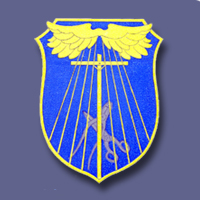 13th Communications Construction Squadron Insignia 13th Communications Construction Squadron Insignia |
||||
| 604th Communications Squadron (Operations) | ||||
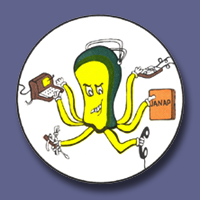 604th Communications Squadron Insignia 604th Communications Squadron Insignia |
||||
| (Source: Email from Paul Laffitte, 604thCS, 1957-58) | ||||
| I was a member of the 604th Comm Sqdn from 1957-1958 and worked up at the Bann "A" site, across the road from a RRL outfit sitting on top of Kindsbach Cave. We were the HF ground station/receiver site for the "ALO" operations (Air Liasion Officer with the Army Divisions out in the field). A mile or so up the road was the Bann "B" transmitter site containing about 5-6 6x6 vehicles with SCR399 units on them. The vehicles were frozen in place and had to be removed one at a time to Ramstein to be rehab'ed to become mobile again. A lot of the radio operators "29352/70"s were "rejects" from the Air Force Security Service 2nd/6911th Radio Sq Mobile from Darmstadt Germany who had lost their "Need to Know" (security clearance) after marrying Foreign Nationals. Before leaving Bann, I was taken on a tour of the Kindsbach Cave and introduced to the Tech Control Facility and asked if I would like to get into that career field. It didn't look interesting but upon getting my orders for the ZI, I was directed to cross train into TCF at Andrews AFB. I became a TCF'er and in 1965, returned to the Bann M/W site (almost sure it was the old 604th Transmitter site) as NCOIC of Tech Control with the Det 6, 2134th Comm Group out of Sembach. New construction was later started on a new operations building and an "Eifel Tower" for the antennas. The new building also contained the old "Pinball Machine" brought up from Kindsbach site. When I left in July 1968 it had not been fully activated. Reason for sending this is that there was no mention of the 604th role in the "ALO" operations. My history to start. Enlisted in AF after high school class of 1947. Went thru basic, Lackland and then on to Radio Op school at Scott. Graduated early 1949, went to Germany for the AF Security Service but at Marburg was sent to Fassberg RAF station in N. Germany for the Airlift. After the lift, July 1949, was sent to my original assignment with the 2nd Radio Squadron Mobile, Darmstadt Germany. Left in 1952 and returned to the same unit now the 6911th RSM in 1955. Got married in 1957 to a German National, lost my "need to know" and like others was shipped out to the 2nd Comm Grp, 604th Comm Sqdn at Ramstein as a 29370 Radio Ops Supv. That's how I wound up at the 604th. |
||||
| (Source: The Comm Net, June 1961 Edition) | ||||
| Communicators of 604th Play Decisive Role in Defense System A guide frequently used by newsmen to insure full coverage of a story is to ask the questions Who?, What?, Where?, When?, and Why? - It would seem reasonable, then, to answer these five questions to give the reader the fullest possible coverage of our subject. Let's begin by asking, "What is the 604th Communications Sq (Operations)?" - The 604th, according to its mission assignment, furnishes fixed tactical communications support for the Seventeenth Air Force Combat Operations Center, mobile communications for the Air Support Operations Center of the Seventeenth, and communications support for other organizations as directed by Headquarters, 2nd Communications Gp; it also operates the USAFE Command High-Frequency/Single-Side-Band voice net terminals ("Twilight") on Ramstein Air Base. In short, the squadron is an operational unit providing fixed communications support to COC and mobile support to ASOC, with additional mobile support commitments for various U.S. and NATO operations in Europe. |
||||
|
||||
| The squadron's present location was established in April 1953 when the unit moved to Ramstein AB, Germany, as a member of the Twelfth Air Force. On 15 Nov 1954, a little more than 10 years from its original activation date, the squadron was redesignated the 604th Communications Sq. (Operations). The unit is now a part of the Seventeenth Air Force. From the early days of 1944 to the present has been a long and not always easy path, and many men pride themselves on having been members of our organization. Whatever the unit designation may be or have been in the past, - we, the men assigned to the 604th, will do our utmost to maintain the proud tradition and fine reputation of the squadron. |
||||
| (Source: The Comm Net, February 1960 Edition) | ||||
| They Put The World at our Fingertips Twilight Radio Team, situated high on a hill overlooking Ramstein Air Base, provides instant voice communications for priority calls. A phone rings at an air base hundreds of miles away a hand reaches out and picks up the telephone. The voice at this end of the line begins, "This is Colonel Cobb at Rodersheim Air Base, Germany. I would like to speak to Major Jones." The called party is contacted and thus commences another important conversation. Most of us, familiar with everyday use of telephones would consider the foregoing call ordinary. However, looking into the procedure of how this, as well as many other similar calls are processed by Radio-telephone, one sees that there is "more than meets the eye." What is "Twilight Radio?" How is it different from the ordinary telephone land line system? High on a hill overlooking Ramstein Air Base is the Radio Telephone (R T) net control center known as "Twilight Radio". Its mission is to provide instantaneous voice communications with points half-way around the world. Actually there are seven different stations with which "Twilight Radio" maintains contact through the use of its 4 single sideband (SSB) Transmitter/Receiver facilities. |
||||
|
||||
| When asked the advantage of R/T over ordinary telephone land lines TSgt Richard D. Beck, NCOIC, stated that the principal advantage was the elimination of the necessity of land lines, in addition to the convenience of a radio capability associated with any telephone on the base. He went on to add that the range of SSB equipment is much greater than ordinary High Frequency Radio equipment. "Twilight Radio" could readily establish contact with stations in the ZI. Because of the transoceanic telephone cables, R/T is not used except in case of a cable breakdown. R/T could maintain contact and carry the load until the trouble was eliminated. Perhaps the most rewarding task recently assigned to "Twilight Radio" was being the primary air ground air communications support facility for President Eisenhower's recent good will tour known as "Operation Monsoon". "Twilight Radio" first established contact with the president's plane, when it reached landfall over the European continent of the beginning of the tour and "stayed with it" until it departed the African coast on its return to the ZI. |
||||
| (Source: The Comm Net, November 1960 Edition) | ||||
| 604th "Puts Finger in Dike" Members of the 604th last Sunday literally put their fngers into the dike and kept the free world's major radar elements in operation. Sunday, Dec 4th, winds of 65 mph, with gusts some 30 mph more, practically erased the communications building at the 603rd ACW Sq's location at Langerkopf. "This all important link in the free world's radar net would have stayed out of operation for quite some time," says Lt Col Frank A. Koszarek, Sector Operations Commander, "had it not been for the immediate action of the 604th's mobile communications people." |
||||
|
||||
Related Links: |
||||
